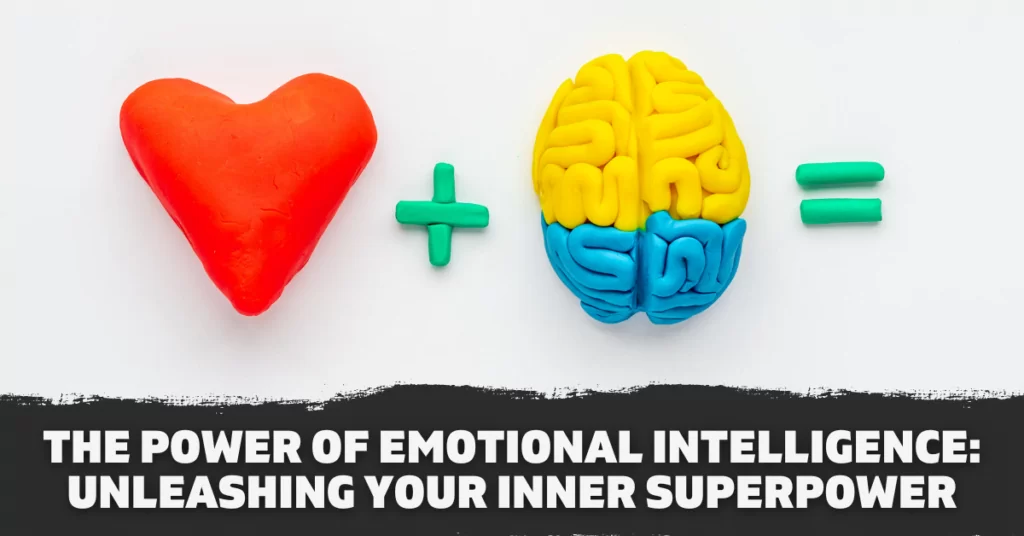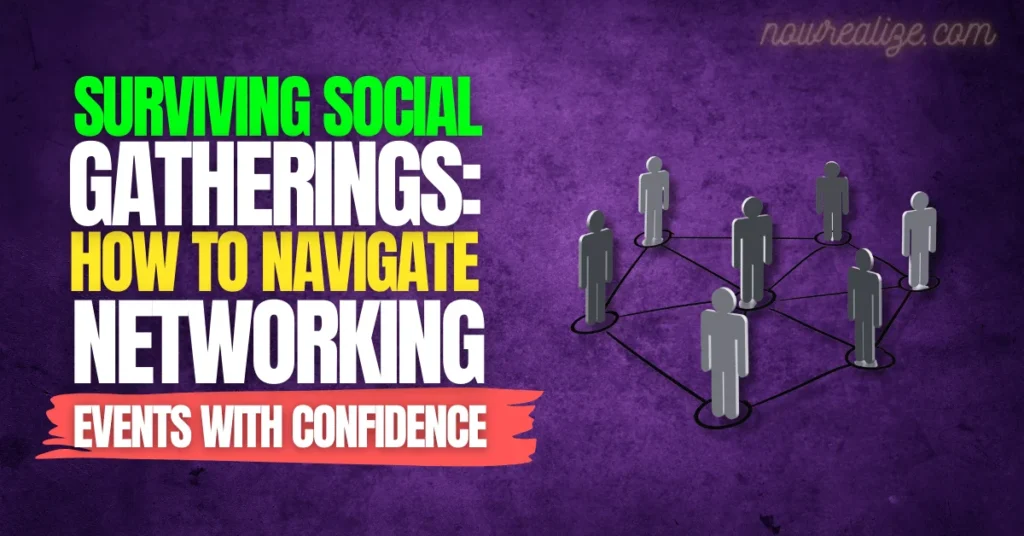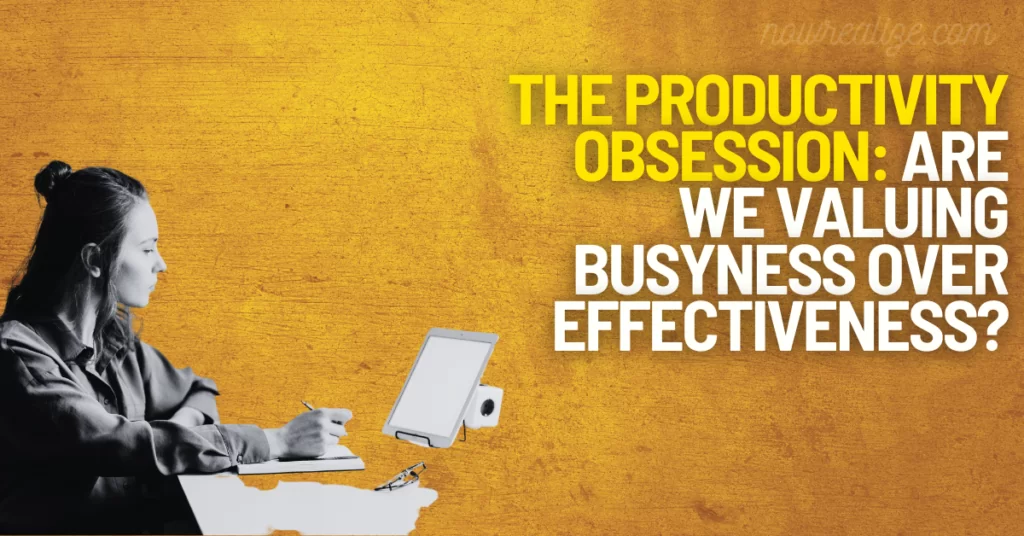
Table of Contents
Introduction
Our lives in the twenty-first century are punctuated by a continuous quest for production. It’s the gold standard, the symbol of success, and the steady drumbeat in our daily lives. Our world moves at a rate that would astound our forefathers, and productivity is the finish line, the checkpoint we’re all attempting to cross. so what is The Productivity Obsession?
“Productivity is the motor that propels us toward our goals, but it, like any engine, requires regular maintenance.” – John Doe
Productivity is not an option; it is a requirement. From corporate cubicles to remote workers’ kitchen tables, there is an unwritten rule that one must always be productive. The more we accomplish, the more successful we are thought to be. But here’s the catch: in our eagerness to be active, are we mistakenly prioritizing activity over effectiveness?
Thesis Statement: Examining the Balance Between Busyness and Effectiveness
This article dives into the complexities of productivity obsession, where the constant drive to stay busy frequently overshadows the end goal – effectiveness. The modern world’s obsession with busyness can result in burnout, tension, and a distorted sense of accomplishment.
Through the prism of “The Productivity Obsession,” we’ll delve into the essence of productivity, its historical growth, and the various perspectives that surround it. This voyage will highlight the paradox of busyness, the dangers of living an unbalanced life, and the necessity to rethink our approach to production.
As we progress through this investigation, it becomes clear that productivity isn’t about doing more, but about doing better. It’s about appreciating the worth of our time, identifying our priorities, and achieving the elusive balance between busyness and effectiveness. True productivity is distinguished by mindfulness, the ability to multitask, and the delicate art of work-life balance.
This blog will help you find the true core of productivity. It’s about taking a step back from the edge of craziness and rediscovering the thrill of being truly effective. Come along with us as we explore “The Productivity Obsession.”
I. The Busyness Paradox
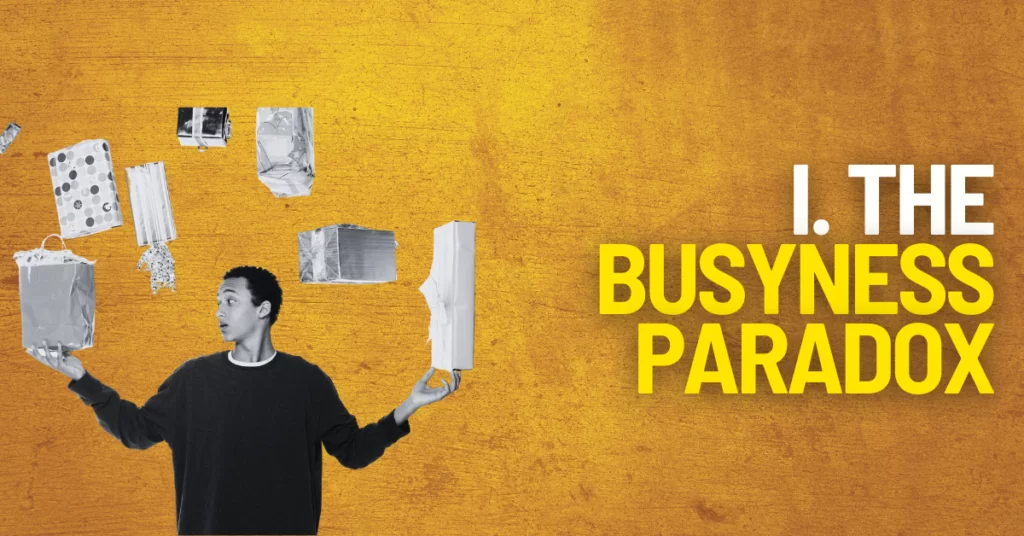
A. The Modern Work Culture
One recurring trend emerges in the ever-changing face of the modern workplace: busyness. Busyness is frequently associated with productivity in today’s workplace. Long hours, multitasking, and continual connectedness are not only the norm; they are celebrated.
The traditional 9-to-5 workweek has given way to a 24-hour work cycle. Emails fill our inboxes at all hours of the day and night, virtual meetings blur the border between work and home, and the pressure to stay ‘ switched on’ is great. In the rush to be more productive, we’ve become caught up in a society that values busyness over effectiveness.
B. The ‘Hustle’ Culture
The ‘hustle’ culture has exacerbated this fixation with busyness. It praises the idea that success belongs to those who are constantly on the move, constantly pushing their limits. Downtime, according to the hustling culture, is a luxury only the unambitious can afford. It causes people to overcommit, overwork, and, sadly, disregard their own well-being.
However, the nasty underside of the hustle culture is frequently disregarded. Burnout, worry, and stress lurk just beneath the surface, ready to devour those who push themselves too far. It is not a sustainable culture, nor is it associated with actual effectiveness.
C. Perception of Being Busy vs. Being Productive
In the middle of this never-ending busyness, the perception of productivity has shifted. We often conflate being busy with being productive, despite the fact that the two are not synonymous. The modern work culture frequently rewards individuals who are continuously on the move, but we must question ourselves whether we are genuinely accomplishing more or chasing an illusion of productivity.
This paradox raises an important question: Is activity a means to an end, or has it become an end in and of itself? Are we losing sight of what it means to be truly productive in our struggle to satisfy the demands of modern life?
As we progress through “The Productivity Obsession,” we’ll uncover the complexities of this busyness paradox. We’ll look at the toll it has on our health and try to rediscover the genuine meaning of productivity – a balance that values both our output and our entire quality of life.
II. The Downsides of Busyness
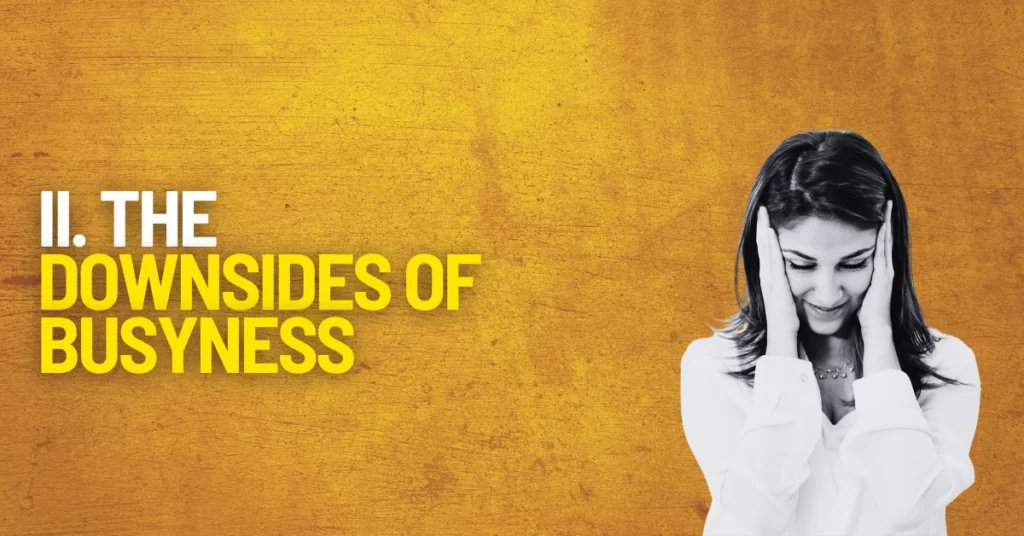
A. Stress and Burnout
Stress and burnout are frequently lurking around the corner in the persistent pursuit of busyness. The stresses of a busy life might contribute to increased stress levels. Unmanaged stress creates a fertile ground for burnout, a state of emotional, bodily, and mental weariness. Burnout impacts not only work performance but also every element of life, destroying one’s feeling of well-being.
The “always-on” society, combined with the incessant need to achieve more, can push people over the edge. The accompanying stress and exhaustion are concerning indicators that we are prioritizing busyness over effectiveness.
B. Impact on Mental Health
The busyness pandemic has a significant impact on mental health. The never-ending demands of production, along with the weight of perfectionism and continual comparison to others, frequently result in anxiety, despair, and other mental health disorders. The stress of juggling several duties and obligations may be exhausting, leaving people mentally drained and, at times, disheartened.
Mental health should be a non-negotiable priority, but productivity often takes first. Recognizing and tackling the detrimental effects of activity on mental health is critical in our quest to redefine productivity.
C. Negative Effects on Personal Relationships
Personal connections can be strained by the constant pursuit of productivity. Friends and family are frequently the victims of our busyness, as we choose work above meaningful time with loved ones. Neglected relationships can lead to strained ties and a sense of isolation, emphasizing the unintended consequences of prioritizing busyness above effectiveness.
It is critical to remember that true productivity should complement rather than detract from our lives. It is critical to rethink our attitude and learn to strike a healthier balance in order to avoid relationship breakdown.
Productivity should not be pursued at the price of our well-being and relationships. It’s past time to rethink our principles and priorities.
III. The Effectiveness Dilemma

A. Defining Effectiveness
The compass that guides us through the maze of productivity is effectiveness. To be effective, we must direct our energy and resources toward worthwhile goals. It is about attaining results that are consistent with our ideals, both personally and professionally. Effectiveness is more than just activity; it is about deliberate action.
Understanding the essence of effectiveness is critical in our drive to redefine productivity. It is not about doing more, but rather about doing better. When we prioritize effectiveness above activity, we focus on outcomes that genuinely matter.
B. The Art of Prioritization
Prioritization is an essential skill for success. It entails selecting tasks and goals with care based on their importance and impact. By determining what genuinely matters, we may direct our efforts to produce the most significant results.
Prioritization enables us to be deliberate in how we spend our time and resources. It enables us to make deliberate choices rather than being swept away by the never-ending tsunami of bustle.
C. The Role of Time Management
Productivity is based on the foundation of effective time management. It is the capacity to balance urgency and importance in how we allocate our time to assignments. By mastering time management, we can avoid busyness from taking over and guarantee that our hours are spent on activities that truly propel us ahead.
Time management is not about cramming more chores into the day, but rather about making time for what is most important. It’s a proactive approach to productivity that allows us to reclaim our time from the grip of busyness.
As we delve more into “The Productivity Obsession,” it becomes evident that effectiveness is not the opponent of productivity; rather, it is its core. When we emphasize effectiveness, we choose a route that prioritizes quality over quantity and purpose over busyness. We’ll look at the myth of multitasking, the value of mindfulness, and the significance of work-life balance in our pursuit of true productivity in the next parts.
IV. The Myth of Multitasking
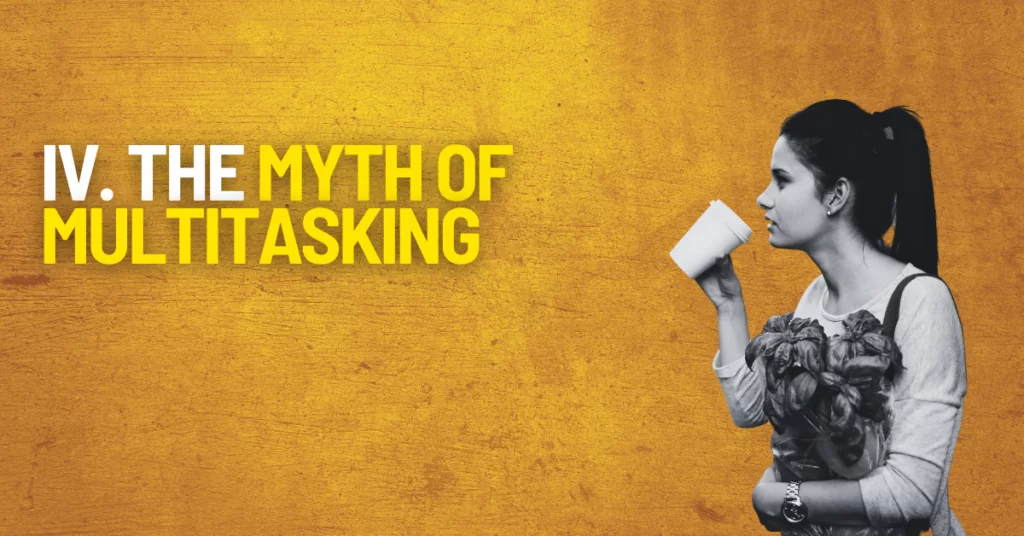
A. Multitasking vs. Single-Tasking
The myth of multitasking has long dominated our pursuit of productivity. The ability to handle multiple things at once is typically considered a mark of efficiency. However, in order to achieve actual effectiveness, it is necessary to tackle this fallacy.
Multitasking, rather than being a blessing, can be a curse. According to research, it frequently leads to decreased productivity since our attention is fractured and our focus is divided. Single-tasking, on the other hand, is the discipline of focusing your entire attention on one job at a time, resulting in higher involvement and, eventually, greater effectiveness.
B. Cognitive Science Behind Multitasking
The cognitive science of multitasking sheds light on why our brains fail to successfully manage numerous tasks. Our brains are wired to focus on one job at a time, and dividing our attention increases our cognitive load. This, in turn, impairs our capacity to complete any of the duties effectively.
Understanding the physics of multitasking is essential for debunking the myth and reframing productivity.
C. Strategies for Effective Single-Tasking
It is possible to shift one’s mindset from one that appreciates multitasking to one that prioritizes single-tasking. Setting clear priorities, minimizing distractions, and devoting focused, uninterrupted time to a task are all components of effective single-tasking. It’s a conscious decision to prioritize quality over quantity.
In the pursuit of “The Productivity Obsession,” switching from multitasking to single-tasking is a big step. We’ll look at tactics and approaches that can help people harness the power of concentrated attention and the dramatic influence it can have on their effectiveness.
V. The Power of Mindfulness

A. Mindfulness and Productivity
In our never-ending pursuit of productivity, we frequently neglect one powerful tool that can revolutionize our approach: mindfulness. Mindfulness is more than simply a relaxing practice; it is a potent productivity booster. Mindfulness can dramatically increase your effectiveness by creating a profound connection with the present moment.
You become more conscious of your thoughts and behaviors when you practice mindfulness. This awareness allows you to make purposeful decisions about where to direct your attention, allowing you to prioritize work with clarity and purpose.
B. Techniques for Practicing Mindfulness
Mindfulness is not a difficult notion to grasp; it simply refers to being present and fully involved in the work at hand. We’ll look at practical mindfulness techniques that you may include in your regular routine. These approaches range from simple breathing exercises to mindful meditation activities, providing a variety of tools to help you be more productive.
By practicing mindfulness, you will be better equipped to deal with the distractions and activities that frequently impede true effectiveness.
C. Real-Life Success Stories
Real-life success stories best demonstrate the transformative effect of mindfulness on productivity. Mindfulness has been used by individuals and organizations to improve their effectiveness, well-being, and overall performance.
We’ll delve into these uplifting stories, demonstrating how mindfulness has propelled them to greater productivity. Seeing the real-world impact of mindfulness will inspire you to incorporate it into your own life.
As we continue our investigation into “The Productivity Obsession,” mindfulness emerges as a transformation agent. It provides a way out of the shackles of busyness and into a revitalized sense of effectiveness. In the parts that follow, we’ll learn about the significance of work-life balance and the rationale for a more holistic approach to productivity.
VI. Finding Your Work-Life Balance
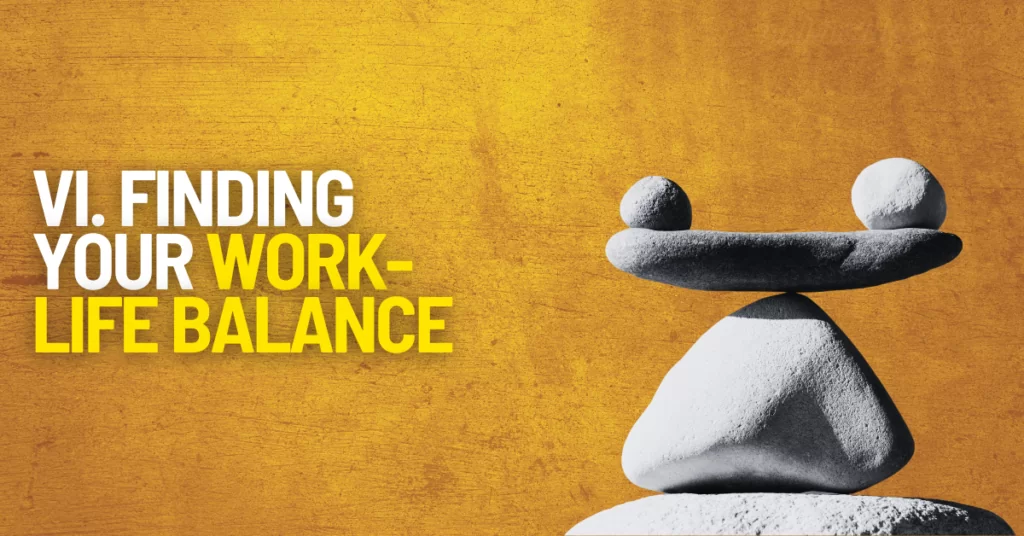
A. Balancing Work and Personal Life
Work-life balance is the pivot point on which the productivity scale tips. The never-ending pursuit of busyness frequently pushes personal life to the sidelines, but it’s a balance we must establish. To be fully effective, we must balance our work and personal lives.
Work and personal life must not be allowed to consume one another. It’s about setting limits, making time for both professional and personal pursuits, and making sure that personal connections, hobbies, and self-care don’t suffer as a result of the productivity obsession.
B. Strategies for a Healthy Work-Life Balance
Balancing these two parts of life necessitates intentional planning. We’ll look at practical techniques that help people keep their equilibrium. These tactics include time management, boundary setting, mindfulness practice, and recognizing the particular combination of activities that replenish your spirit.
A healthy work-life balance is not a luxury, but rather a must for long-term productivity and well-being.
C. The Impact of Balance on Productivity
Balance has a significant impact on productivity. We are more effective during working hours when we have a healthy work-life balance since we are well-rested and psychologically prepared. Furthermore, personal joy and fulfillment pour over into professional pursuits, promoting innovation and motivation.
Finding and maintaining a work-life balance improves not just your quality of life but also your overall productivity.
As we near the end of “The Productivity Obsession,” we’re reminded that effectiveness isn’t just about how much work you can get done, but also about how well-rounded and full your life is. A balanced approach to productivity prioritizes both personal well-being and professional achievement. In the following section, we’ll look at real-life case studies that highlight the importance of this balancing.
Frequently Asked Questions (FAQs)

1. What’s the difference between being busy and being productive?
Being busy usually entails a frenzy of activity, often with no apparent aim or end goal in mind. It might be chaotic and leave you feeling completely overwhelmed. Being productive, on the other hand, entails directing your efforts toward meaningful tasks that match your goals. It is about generating meaningful accomplishments and managing your time with purpose and intention.
2. Can you be productive without being busy all the time?
Absolutely. Productivity does not imply being constantly preoccupied. In truth, true productivity frequently necessitates periods of concentrated effort and deliberate rest. Quality takes precedence over quantity. Being productive is knowing when to work hard and when to rest, ensuring that your efforts have an impact rather than being unending.
3. How does technology impact our perception of productivity?
Technology has a huge impact on our impression of productivity. While technology provides productivity tools, it can also be a source of distraction. Constant connectivity and the urge to be ‘always on’ can muddle the distinction between work and personal life. Technology management is critical for keeping a healthy balance and redefining productivity.
4. What are the signs of burnout due to over-busyness?
Burnout frequently presents as physical and emotional symptoms. Chronic tiredness, increased irritation, loss of motivation, and a reduction in work performance are examples. Recognizing the early warning signals is critical for avoiding burnout, which can occur from an unwavering focus on busyness.
5. How can mindfulness practices improve productivity?
Mindfulness activities boost productivity by encouraging a clear, present-focused mentality. They alleviate tension, boost concentration, and aid in decision-making. Mindfulness enables you to work with intention, minimizing the effects of interruptions and increasing overall performance.
6. What’s the link between work-life balance and productivity?
Work-life balance and productivity are inextricably linked. A well-balanced life keeps you well-rested, cognitively and emotionally healthy, and ready to offer your all at work. A balanced person is more motivated, creative, and focused, which leads to increased productivity and job satisfaction.
7. How do effective leaders promote productivity and well-being?
Effective leaders understand that productivity is about more than simply numbers; it is also about the well-being of their team. They foster a work atmosphere that promotes a balanced lifestyle, offers possibilities for advancement, and cherishes each team member’s mental and emotional well. This strategy promotes productivity and loyalty.
8. Is self-care a luxury or a necessity for productivity?
Self-care is a requirement, not a luxury. It is a necessary component of maintaining good mental and physical health. Ignoring self-care can result in burnout and lower output. Prioritizing self-care guarantees that you are in the greatest possible condition to excel in both your personal and professional lives.
9. How can individuals find the right balance between busyness and effectiveness?
Setting clear objectives, practicing time management, embracing mindfulness, and being attentive to self-care are all part of finding the proper balance. It also necessitates continual self-evaluation and change, because balance is dynamic and specific to each individual’s circumstances and goals.
Conclusion
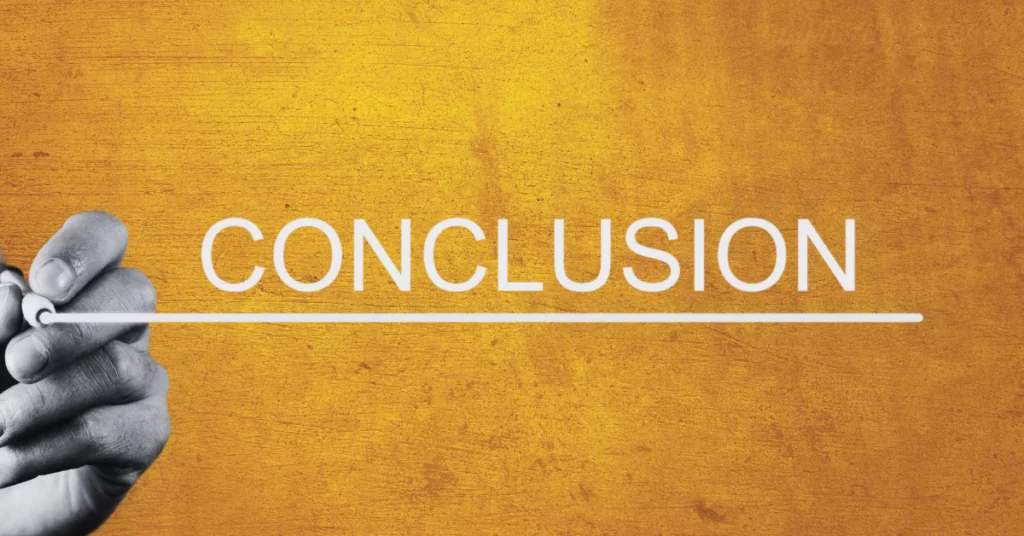
Recap of Key Points
Throughout our investigation into “The Productivity Obsession,” we’ve been on a journey into the maze of modern productivity. We’ve deconstructed the paradox of busyness, investigated the dangers of an unbalanced lifestyle, and applauded the essence of true effectiveness. The fallacy of multitasking has been exposed, as has the transformational effect of mindfulness. We investigated the significance of work-life balance and sought inspiration from others who have reinvented productivity.
The Call for Reevaluating Priorities
This quest is a rallying cry for us to reconsider our priorities. The productivity craze has frequently led us wrong, rewarding bustle above actual performance. It serves as a reminder that great productivity isn’t linked with nonstop work, but rather with deliberate participation. The invitation is to take a step back from the frenzy of work and embrace a more balanced, focused, and deliberate approach to productivity.
Encouragement for a Balanced Approach to Productivity
We must not lose sight of the core of life itself in our never-ending chase of productivity. Balancing work and personal life demands is not a luxury; it is a need. It’s a reminder to value personal well-being as much as professional achievements. It’s an invitation to achieve balance, value effectiveness above activity, and rediscover the joy of being truly productive.
As we round off “The Productivity Obsession,” keep in mind that life is not a competition to be the busiest, but rather a journey to be the most effective. Your productivity should promote rather than decrease your well-being. The future of productivity is determined not by how much you can achieve, but by how well you can achieve it. We salute to changing productivity one mindful, balanced stride at a time.
We’d love to hear what you think about this journey. Fill up the blanks with your thoughts and comments. What are your thoughts on productivity and striking a balance between busyness and effectiveness?



